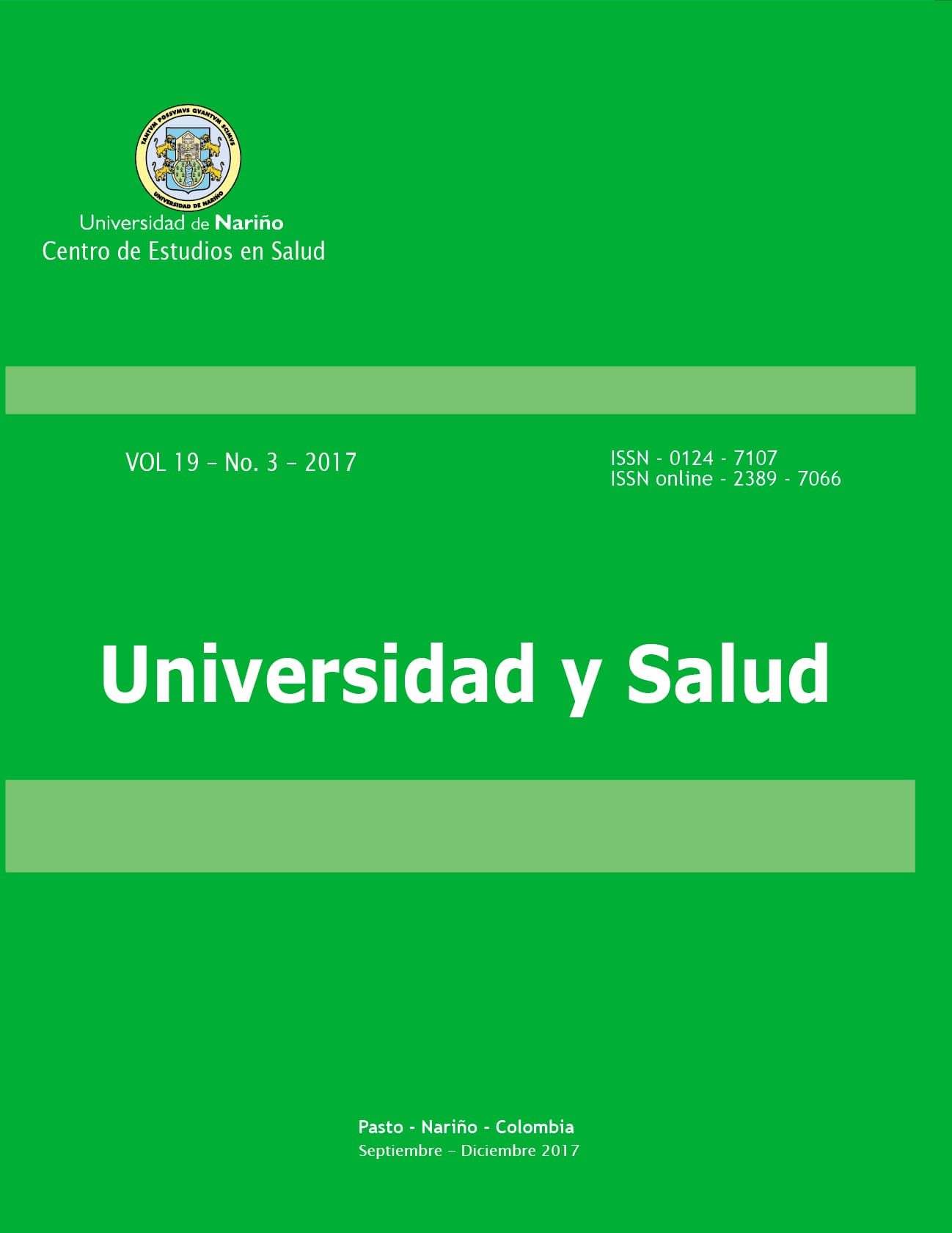Aplicación de los árboles de decisión en la identificación de patrones de lesiones fatales por causa externa en el municipio de Pasto, Colombia
DOI:
https://doi.org/10.22267/rus.171903.101Palabras clave:
Reconocimiento de normas patrones automatizadas, Minería de datos, Árboles de decisión, ClasificaciónResumen
Introducción: La Organización Panamericana de la Salud (OPS) desde el año 1993 y la Organización Mundial de la Salud (OMS) en 1996, aceptaron que la violencia es un problema de salud pública, situación que se corrobora en el Informe de Violencia y Salud, en el cual América Latina presentó una tasa de homicidios de 18 por cada 100.000 personas, y es considerada como una de las regiones más violentas del mundo. Objetivo: Detectar patrones delictivos con técnicas de minería de datos en el Observatorio del Delito del municipio de Pasto (Colombia). Materiales y métodos: Se aplicó Cross Industry Standard Process for Data Mining (CRISP-DM), una de las metodologías utilizadas en el desarrollo de proyectos de minería de datos en los ambientes académico e industrial. La fuente de información fue el Observatorio del Delito del municipio de Pasto, donde está almacenadas las cifras históricas, limpias y transformadas sobre las lesiones de causa externa (fatales y no fatales), registrados en 11 años. Resultados: Se construyó un modelo de clasificación basado en árboles de decisión que permitió descubrir patrones de muertes por causa externa. Para el caso de homicidios, estos sucedieron en su mayoría en la Comuna 5 de Pasto, los fines de semana, en la madrugada, en el segundo semestre del año, en la vía pública y las víctimas fueron hombres adultos, de oficios varios, la causa de los homicidios fueron riñas y se produjeron con arma de fuego. Conclusión: El conocimiento generado ayudará a los organismos gubernamentales y de seguridad a tomar decisiones eficaces en lo relacionado a la implementación de planes de prevención de delitos y seguridad ciudadana.
Descargas
Métricas
Citas
Chen H, Chung W, Qin Y, Chau M, Xu JJ, Wang G, et al. Crime Data Mining : An Overview and Case Studies. Commun ACM. 2002;2:165-276.
Perversi I, Valenga F, Fernández F, Britos P, Garcia-Martinez R. Identificación y Detección de Patrones Delictivos basada en Minería de Datos. En: IX Workshop de Investigadores en Ciencias de la Computación; Trelew, Argentina 2007. Trelew: Red de Universidades con Carreras en Informática (RedUNCI); 2007. p. 385-9.
Schotborgh M, Laverde N, Valbuena Y, Blandón A. Protocolo de Vigilancia en Salud Pública: Lesión de Causa Externa. Bogotá: INS; 2016.
Instituto CISALVA. Sistematización de Experiencias sobre Sistemas de Vigilancia, Observatorios o Sistemas de Información de Violencia en América Latina. Cali,: Centro Editorial CATORSE SCS; 2009. 62 p.
Instituto CISALVA. Guía Metodológica para la Replicación de Observatorios Municipales de Violencia. Cali: Centro Editorial CATORSE SCS; 2008. 45 p.
Betancourt C. Vigilancia de lesiones de causa externa para la toma de decisiones en el nivel local, experiencia de Pasto, Colombia, 1 diciembre de 2004 - enero 15 de 2005. Inf Quinc Epidemiol Nac. 2005;10(12):177-92.
Valenga F, Fernández E, Merlino H, Procopio C, Britos P, Garcia-Martinez R. Minería de Datos Aplicada a la Detección de Patrones Delictivos en Argentina. En: VI Jornadas Iberoamericanas de Ingeniería de Software e Ingeniería del Conocimiento; Guayaquil, 2008. Guayaquil: Escuela Superior Politécnica del Litoral Facultad de Ingeniería Eléctrica y Computación Área de Ingeniería en Software VLIR -ESPOL Componente 8; 2008. p. 427.
Sentient. DataDetective Sentient Information Systems [Internet]. Ámsterdam: Sentient; 2012. Disponible en: http://sentient.nl/docs/ReleaseNotes_DataDetective2012_NL.pdf
Chen H, Chung W, Xu J, Wan G, Qin Y, Chau M. Crime Data Mining: A General Framework and Some Examples. IEEE Comput Soc. 2004;37(4):50-6.
Hauck R, Atabakhsh H, Ongvasith P, Gupta H, Chen H. Using Coplink to Analyze CriminalJustice Data. IEEE Comput. 2002;35:30-7.
Reza K, Javideh M, Reza E. Detecting and investigating crime by means of data mining: a general crime matching framework. Procedia Computer Science. 2011;3:872-80.
Valenga F, Perversi I, Fernández E, Merlino H, Rodríguez D, Britos P. Aplicación de Minería de Datos para la Exploración y Detección de Patrones Delictivos en Argentina. En: XIII Congreso Argentino de Ciencias de la Computación; Argentina, 2007. Argentina: Universidad Nacional del Nordeste; 2008. p. 1868.
Montt C, Rubio J, Lanata S. Análisis de accidentes de tránsito con Inteligencia Computacional. XVI Congreso Chileno de Ingeniería de Transporte. 2013;(16):1-11.
Azevedo A, Santos M. KDD, SEMMA and CRISP-DM: a parallel overview. In: IADIS European Conference on Data Mining. Amsterdam, Netherlands; 2008. p. 182-5.
Timaran R, Baron A, Hernàndez G, Arsenio H, Betancourth C. SIGEODEP: Un primer paso para la Detección de Patrones Delictivos con Técnicas de Minería de Datos. In: Pow-Sang JA, Melgar A, editors. IX Jornadas Iberoamericanas de Ingeniería de Software e Ingeniería del Conocimiento. Lima, Perú: Pontificia Universidad Católica del Perú; 2012. p. 87-94.
Timaran R, Calderón A, Hidalgo A, Baron A, Hernández G. Construcción de un mercado de datos para el almacenamiento de lesiones de causa externa. Vent Inform. 2014;30:67-79.
Gallardo J. Metodología para el Desarrollo de Proyectos en Minería de Datos CRISP-DM. [Internet]. 2009. Disponible en: http://www.oldemarrodriguez.com/yahoo_site_admin/assets/docs/Documento_CRISP-DM.2385037. pdf
Waikato. Weka 3: Data Mining Software in Java [Internet]. Nueva Zelanda: Machine Learning Group at the University of Waikato. Disponible en: http://www.cs.waikato.ac.nz/ml/weka/
Han J, Kamber M. Data Mining: Concepts and Techniques. San Francisco, USA: Morgan Kaufmann Publishers; 2001. 550 p.
Sattler K, Dunemann O. SQL Database Primitives for Decision Tree Classifiers. In: Paques H, Liu L, Grossman D, editors. The 10th ACM International Conference on Information and Knowledge Management. Atlanta, USA: ACM New York; 2001. p. 379-86.
Villena J. CRISP-DM: La metodología para poner orden en los proyectos de Data Science. [Internet]. 2016. Disponible en: https://data.sngular.team/es/art/25/crisp-dm-la-metodologia-para-poner-orden-en-los-proyectos-de-data-science
Hernández J, Ramírez M, Ferri C. Introducción a la Minería de Datos. Fayerman D, editor. Madrid: Pearson Prentice Hall; 2004. 680 p.
García M, Álvarez A. Análisis de Datos en WEKA -Pruebas de Selectividad [Internet]. Disponible en: http://www.it.uc3m.es/jvillena/irc/practicas/06-07/28.pdf
Witten I, Frank E. Data Mining: Practical Machine Learning Tools and Techniques with Java Implementations. San Francisco: Morgan Kaufmann Publishers; 2000. 365 p.
Campbell S, Quintero M. Comportamiento de las lesiones fatales de causa externa en Florencia. Acta Médica Colombiana. 1997;22(4):161-166.
Moya D. Comportamiento de lesiones de causa externa, Colombia, 2013. Bogotá: Instituto Nacional de Medicina Legal y Ciencias Forenses.
Organización Panamericana de la Salud. La Salud en las Américas Edición 2002 Volumen I. Washington: OPS; 2002. 473 p.
Ministerio de Salud de la Nación. Lesiones por causa externa. En: Informe de resultados Segunda Encuesta Nacional de Factores de Riesgo. Buenos Aires: Ministerio de Salud; 2009. p. 182-225.
World Health Organization. The Global Burden of Disease 2004 update. Geneve: WHO; 2008. 160 p.
Organización Panamericana de la Salud. La Salud en las Américas Edición 2012 Volumen de Países: Colombia. Washington: OPS; 2012.
Publicado
Cómo citar
Número
Sección
Licencia
Derechos de autor 2017 Universidad y Salud

Esta obra está bajo una licencia internacional Creative Commons Atribución-NoComercial-CompartirIgual 4.0.




















